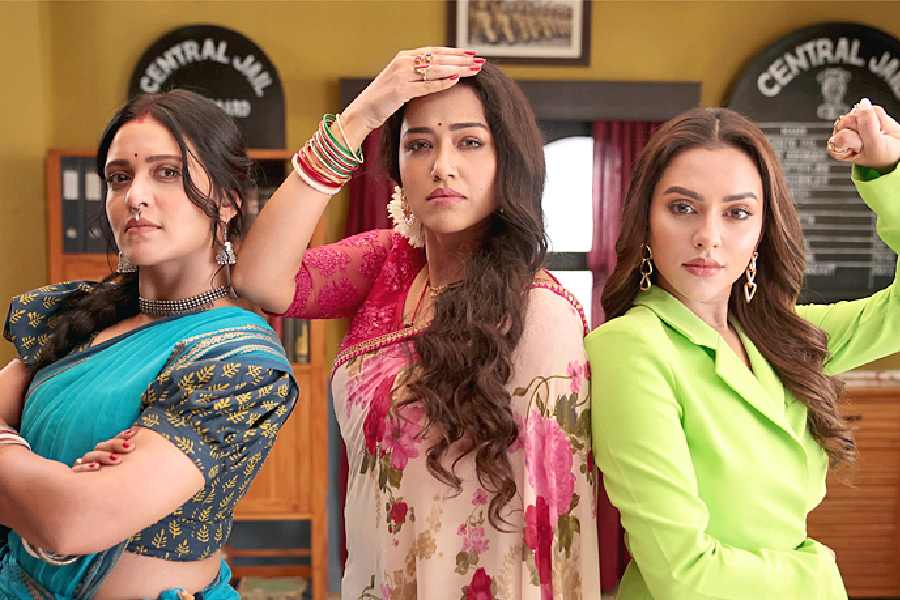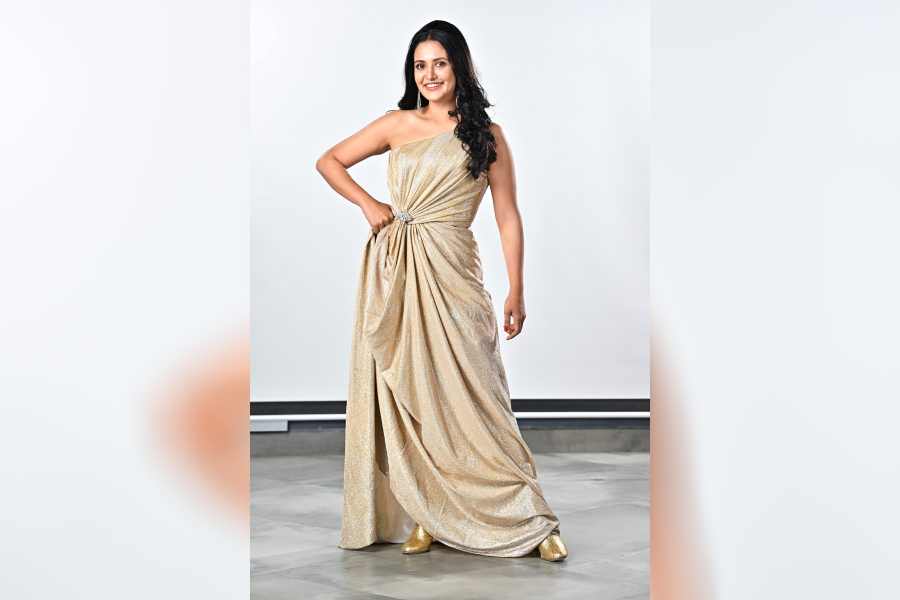Bibaho Obhijaan, starring Anirban Bhattacharya, Rudranil Ghosh, Priyanka Sarkar, Ankush Hazra, Sohini Sarkar and Nusraat Faria, was a 2019 comedy film by Birsa Dasgupta that spoke about the lives of married couples and satisfied the audience with a happy ending. Cut to 2023, Abar Bibaho Obhijaan, with Soumik Haldar in the director’s chair and produced under the SVF banner, travels to Pattaya to explore the lives of the Bibaho Obhijaan couples further through the genre of comedy and entertaining aspects of a commercial film. The Telegraph talks to actress Priyanka Sarkar, starring opposite Anirban Bhattacharya in the film, to know what’s awaiting the audience in the theatres today:
Abar Bibaho Obhijaan is an outand-out comedy, a genre that is not explored much in contemporary Bengali films. What kind of response are you receiving after the trailer release?
We are getting very good responses. The first Bibaho Obhijaan film was a well-appreciated movie and it had a different execution then. The audience only wanted to watch a second part to see how the characters developed. It could have happened earlier, but with Covid and all, it took us some more time to bring the sequel.

Priyanka with co-actors Sohini and Nusraat

Priyanka in her look as Malati
As an actor, what is the most challenging part of playing a role in comedy films?
I think justifying the comedy is the most challenging part. Shooting is a very technical thing. Sometimes we do the last scene before any other scene. The fun we are experiencing for the first time while reading the script or during the rehearsal, after 10 takes, somewhere that spontaneity is lost. Keeping it intact or recreating it becomes challenging. Such comedies are very situational and are based on the actor’s character and performance. Maybe someone delivered a line and we all started laughing. When that is happening for the fourth time, we know what to predict and then to keep the energy intact becomes difficult. But with the great co-actors and the team involved, we did it well.
Bibaho Obhijaan adds a diverse aspect to your body of work. How much did the character allow you to explore your potential as an actress?
Quite a bit. Maintaining the comedy, body language and dialect was very challenging for me. We are performers, our inspiration is the audience. Their love helps us to do better. When we went for various stage shows after the first film, people asked us to say the Malati’s (Priyanka’s character) and Gansha’s (Anirban’s character) dialogues. They wanted to hear the dialogues, poems and songs, and it inspired me as an actor a lot more. Nowadays, we do films that mostly cater to the urban audience. But this is such a film that people from rural areas also like and the urban audience also appreciates the smart humour in it. We don’t get to do this kind of work a lot. Something that everyone can love and work that caters to all kinds of audiences. Both films are that. As a character, Malati is very different from who I am. She is a stubborn, reckless kind of girl. So, playing her was very challenging for me. But I already became this character last time; in this film, I had to just maintain it.
What was the best thing about being a part of Abar Bibaho Obhijaan?
I think the fact that it caters to everyone’s taste and makes everybody laugh. Recently, we went for our promotional event to Haldia, Durgapur… the way the audience was enjoying the dialogues.... So, the fact that it is entertaining for all is the biggest takeaway for us as actors. This chance does not come very often in our life.
From Bhubaneswar and Tarapith in the first film, the story travels to Pattaya this time. What was the shooting experience like?
Beyond shooting, we tried to explore on our own because Thailand means great seafood and a place like Pattaya is full of celebration. There was pressure related to the shooting and after that it was exhausting. Getting up at four and getting ready for the shot and exploring the place after the shoot doesn’t really happen. But what we did was to spend time with each other, gave adda and tried different kinds of food. For the shooting itself, we went to different locations. When we went to Thailand, it was very hot and that was one of the reasons why we couldn’t have much fun. But since the team was great, we had fun amongst ourselves.
The cast remains the same but last time it was directed by Birsa Dasgupta and this time it is Soumik Haldar. What was each of their briefs to you and how did each of their directions help you to portray your character?
I am grateful to Birsada for thinking of me as Malati and the character became well-appreciated due to his guidance and of course Rudrada’s script. Since our script writer was with us, we had to face fewer problems. This time it became easier for us since we know these characters. But these characters belonging to Birpur and how they are reacting when they are going to Thailand, to justify that and establish that was a challenge for the director. But I had worked with Soumikda before. He directed Mahabharat Murders. I am used to his style of work. He is very knowledgeable. He is working as a DoP for a long time, so he is technically very sound and though he had challenges like shooting abroad, actors of different languages and many other things, still he handled everything with a lot of patience.
In the past five years, all six of you grew as actors in the industry. How was it sharing screen space together after five years?
(Laughs) Yes, when we were on set we never realised that five years had passed by in the meantime. That is what happens I guess. The bond revives from where it ends. In the meantime, Covid happened! But not only as performers, we have changed as individuals also. But we had great fun on set and that was a relief for us. Shooting abroad has its own challenges. There were challenges of time and language. But since we knew each other and we had that bonding, the work pressure did not feel like pressure. Even though we are doing it after five years, we had thought of the sequel way before and I think this is a better time to do it. The stress we are all going through, I guess the film can give us relief from that. There’s nothing to think about deeply in this film. People can go together as a family to get entertained and that fun will linger on. I think this is a very good time for such a film.
In the past few years with content-based scripts getting priority, as an actor do you think we have the right kind of audience to appreciate a comedy and commercial film like this anymore?
We are of course very hopeful because the audience increased our expectations from the first film onwards. Bibaho Obhijaan was a very different execution around that time. It was a commercially fun film and we didn’t know whether it would work or not. But it did and we are returning on screen for the audience’s demands only and I think it should work because we are getting very good responses from the trailer and the songs. People still have that eagerness towards this film. Both types of films are important. Since films are a medium to capture the times we live in, just like socially relevant, intense films are necessary; as an audience, we also want films that can give us that entertainment too. Films that will take us abroad, can show us actors wearing chiffon and dancing, something that can make us dream. Such films bring in that larger-than-life perspective that films give us. The audience has proved that when they like the content they support the film. To cater to their wishes we have brought this film. So, we are hopeful.











